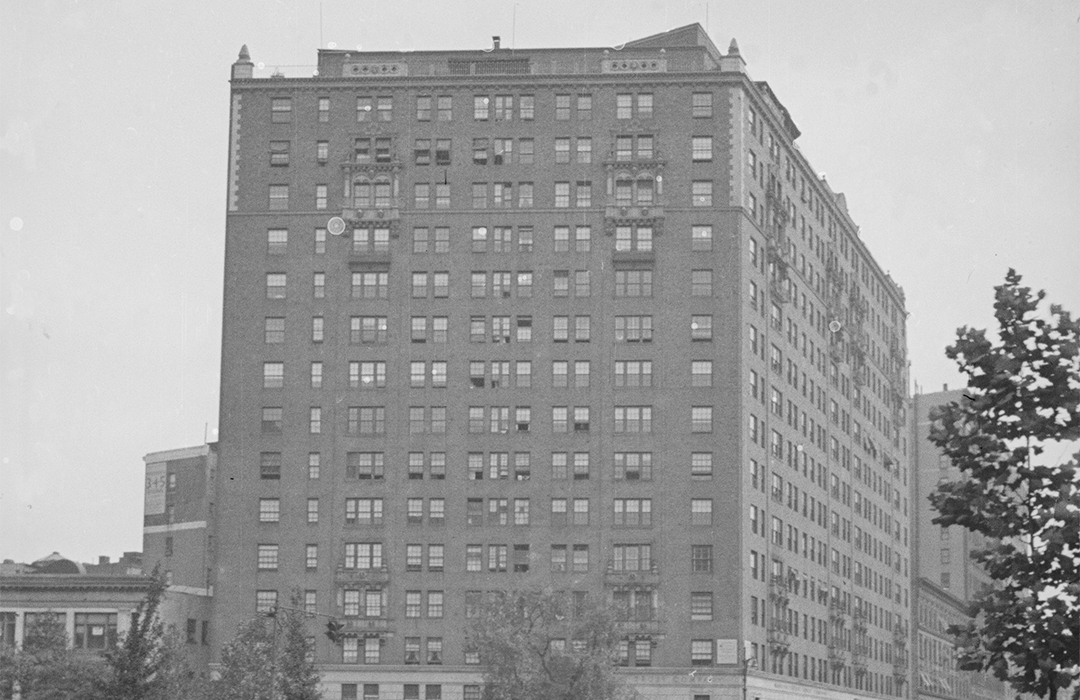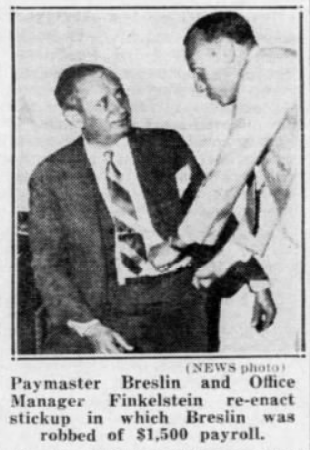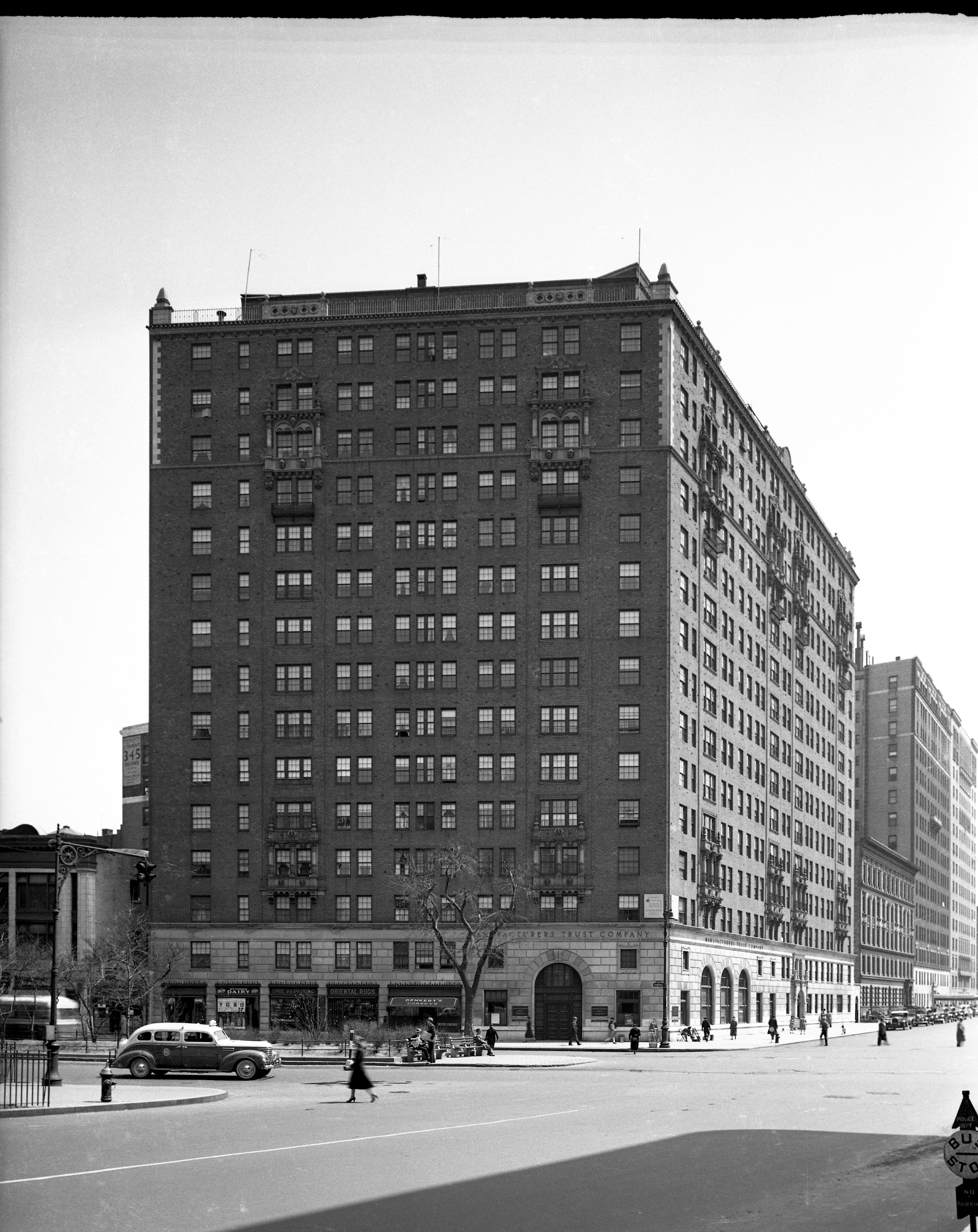
225 West 106th Street
by Tom Miller
In 1927 Albert P. Frymier and William J. Hanna, partners in the development firm of Hanna & Frymier, contracted the architectural firm of Boak & Paris to design a large apartment house at the northeast corner of Broadway and West 106th Street. The 15-story building was faced in red brick above a two-story limestone base. Its Italian Renaissance design was enhanced by pseudo balconies of limestone-colored terra cotta, decorated by the helmeted heads of Renaissance period men. The residential entrance was located at 225 West 106th Street, while the Broadway side held commercial stores—one large corner space which was leased to the Manufacturers Hanover Bank, and two smaller shops.
The upper-middle-class residents enjoyed several unusual amenities—like a bathroom for every bedroom. Among the early tenants was Meyer B. Breslin and his wife. He was secretary-treasurer of the L. & L. Sponging Company at 119 West 25th Street. Until the third quarter of the 20th century, workers were paid in cash, and so once a week a trusted employee would necessarily make a trip to the bank to withdraw the payroll. It was a practice that did not go unnoticed by street outlaws, who tracked the movements of those workers, learned their weekly schedules, and then pounced.
Then another man, also carrying a pistol, opened the driver’s side door and pushed Breslin to the middle of the seat.
On Friday, August 17, 1934, Breslin drove to the Yorktown Bank, withdrew the $1,500 payroll (nearly $35,000 in 2022), and returned downtown. Just as he parked his car on West 25th Street, a gunman opened the passenger door and got in. Then another man, also carrying a pistol, opened the driver’s side door and pushed Breslin to the middle of the seat. He drove northwestward and, according to The New York Sun, “Each time the car passed a policeman Breslin was reminded that the holdup men were armed and was warned against giving an alarm.”
At 27th Street and 10th Avenue, the 38-year-old Breslin was ordered to get out and “to keep walking.” The gunmen drove away in his car. It is unclear whether the bandits were ever caught.
Also living in the building at the time were Henry Ridder, the owner of The Catholic News; Isaac Mendoza and his wife Della; and Robert C. Henry and his wife, the former Bessie Mead. Robert Henry was the treasurer of the Metropolitan Ice Company and of the Mutual Casualty Insurance Company.
Isaac Mendoza was among the city’s best-known dealers in second-hand books. He had established his shop at 15 Anna Street in 1894. Following his death at the age of 72 on November 3, 1937, The New York Times remarked, “Many newspaper men and authors knew Mr. Mendoza and enlisted his aid when seeking special information for books or articles, especially when the history of New York was involved. A trip to his book-cellar usually supplied the needed volume.”
The store at 2766 had been the Spotless Dollar Cleaners in the early 1930’s. But after the repeal of Prohibition, it was taken over by the Reo Dairy. Despite its wholesome-sounding name, the restaurant obtained its liquor license in 1940.
Apartments in the building continued to house well-heeled tenants. John F. Thompson, president of Bankers Trust Company, and his wife lived here in the early 1940’s, and by the 1960’s Gordon C. Kashin and his wife Natalie were tenants. Born in New York City, Kashin became the Moscow correspondent for The London Observer and Business Week, relocating there for the newspaper and magazine in 1936. With the outbreak of World War II, he returned to the United States where he was employed by the Office of War Information in Washington. At the war’s end, he went into a less stressful career. His firm, Kashin & Kashin, specialized in remodeling New York brownstone townhouses.
“but when the money bag exploded outside the bank, he dropped it and fled.”
Another former Government employee was Alice Webber. She had gone into social work in 1921 as a supervisor with the American Red Cross. In 1930 she became a regional representative for the Department of Health, Education and Welfare. She died in her apartment on October 15, 1976, at the age of 82.
A gunman who held up the Manufacturers Hanover Trust Company branch in the building on September 18, 1979, discovered that technology had changed bank robbery. The New York Times reported that he fled to the sidewalk, “but when the money bag exploded outside the bank, he dropped it and fled.”
Manufacturers Hanover Trust Company soon left the corner space it had occupied for decades. In 1987 Rustic Furnishings was there, selling Adirondack twig furniture. A Crabtree & Evelyn store occupied 2768 Broadway at the time. Today two of the stores, including the massive corner space, recently a Duane Reade, are vacant, most likely victims to COVID.
Tom Miller is a social historian and blogger at daytoninmanhattan.blogspot.com
Building Database
Keep Exploring
Be a part of history!
Think Local First to support the local businesses at 2760-2768 Broadway aka 225 West 106th Street:
Meet Christopher Vidal!
Meet Richard Krasilovsky!




